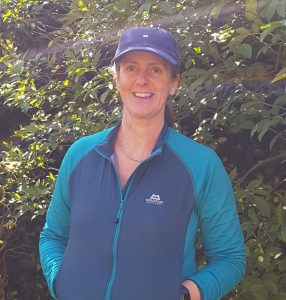Small orchards have in the past been a feature of many farms across the island of Ireland, providing traditional varieties of apples, pears, plums and damsons. The crop from the orchard was sometimes destined for local sale or for use in the home. Fruit trees are usually planted for their crop, but fruit trees and bushes can be used to enhance the farm, as an orchard is a nice feature and great for pollinators and biodiversity.
An apple tree or a fruiting tree can be grown in almost any spare area close to the farm house. If you have an existing orchard on the farm, it’s important to retain this, as it is a valuable biodiversity habitat.
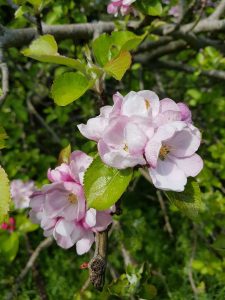 |
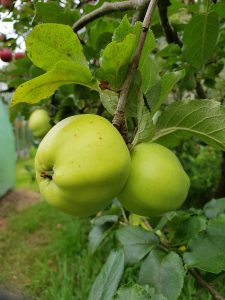 |
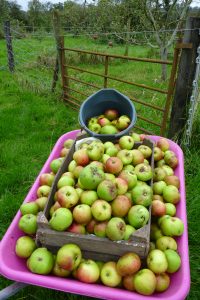
|
How to encourage pollinators in your orchard
In Ireland, bumblebees play an important role in the pollination of our fruit trees. Most fruit growers know that bumblebee pollinators are extremely beneficial in producing both high yields and high-quality products.
Your orchard will benefit from having some native pollinator friendly trees planted nearby, such as, Willow, Rowan, Crab apple and Wild cherry. A native flowering hedgerow, with Hawthorn, Blackthorn, Dog rose, Guelder rose, Honeysuckle and Holly will also provide important food for pollinators in the spring.
Allow Ivy and Bramble to grow in a corner of your orchard as they provide important food sources in late summer and autumn for pollinators. If you can avoid using harmful chemicals, this will also benefit the important orchard pollinators.
Apple tree facts
- There are 68 heritage varieties of apple in Ireland and 6,000 different varieties of apple tree in the world.
- Apples have been grown in Ireland for almost 3,000 years.
- The ancestors of apples as we know them today came from Kazakhstan. They naturally moved along the Silk Road and were then spread further by the Romans.
A sense of place
There’s a lovely connection with many fruit varieties which have historical associations with place names and people throughout Ireland. Some have been bred or discovered in an area and are named after the place they came from or by the person who discovered or raised them. Other varieties were popularly grown in an area.
Decide if you’d like a cooking, eating, crab or cider variety. As well as planting trees that grow best where they originated from you will also be helping to conserve cultural and genetic diversity.
Traditional varieties grown here have wonderful names, they include Ballyvaughan Seedling, Irish Peach, Munster Tulip, Sheep’s Snout, Leitrim Red and Lough Key Crab.
Many of these are hardy, very prolific and are resistant to scab and canker. As well as apples – plum and damson were also common trees in our orchards.
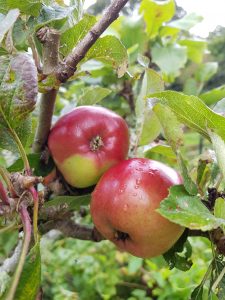 |
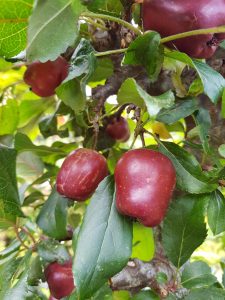 |
ACRES Agri-Climate Rural Environment scheme – general
If you’re considering planting an orchard under the new ACRES general scheme, at least 0.05 hectares is required, planting 10 apple trees from a list of traditional varieties. You can find out more here
Where to plant a new orchard
- Survey your potential site, if the site is already special for biodiversity (i.e. species-rich grassland, long-established woodland), do not change, retain and manage the site carefully.
- Warm, sunny and sheltered, south to south-west facing is best.
- Soil – ideally well drained, uncompacted and loamy.
- Not in a frost pocket or standing water.
- Spacing and layout, in the ACRES scheme trees are to be 5 meters apart.
When to plant
Most apple trees are sold in bareroot form from December to March. They are usually best value, have used less resources to grow, can offer more choice of varieties, and handy to mail order. They tend to grow well, often getting settled in and grow faster than pot grown plants.
They do, however, require careful handling, the bare roots must not dry out or get exposed to the elements. Bareroot plants are only available when they are dormant, between November and early April.
There’s nothing better than home grown apples, pears and damsons, their smell and taste are so good in the autumn. It’s the perfect time of year to plan a small orchard on your farm.
To find out more
Irish Seed Savers https://irishseedsavers.ie/
The Organic Centre https://www.theorganiccentre.ie/conservation/orchard
RHS Pollinator groups https://www.rhs.org.uk/advice/beginners-guide/fruit-basics/fruit-pollination
By Ruth Wilson, Farmland Pollinator Officer, All-Ireland Pollinator Plan

